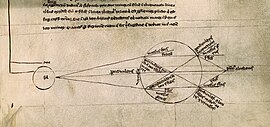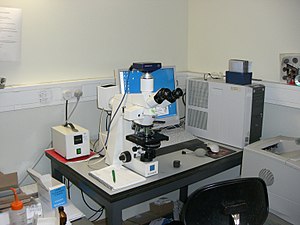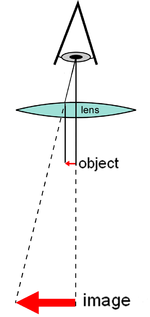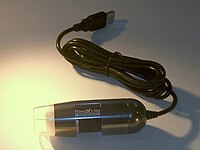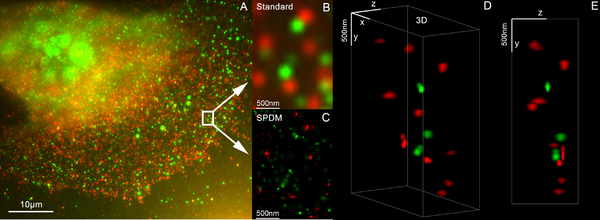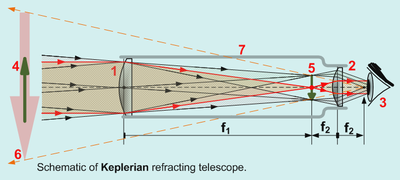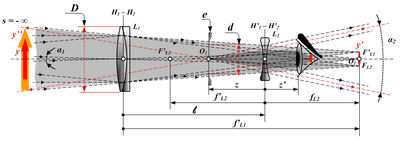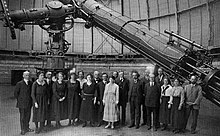The earliest known lenses were made from polished crystal, often quartz, and have been dated as early as 750 BC for Assyrian lenses such as the Nimrud / Layard lens. There are many similar lenses from ancient Egypt, Greece and Babylon. The ancient Romans and Greeks filled glass spheres with water to make lenses. However, glass lenses were not thought of until the Middle Ages.
Some lenses fixed in ancient Egyptian statues are much older than
those mentioned above. There is some doubt as to whether or not they
qualify as lenses, but they are undoubtedly glass and served at least
ornamental purposes. The statues appear to be anatomically correct
schematic eyes.
In ancient India, the philosophical schools of Samkhya and Vaisheshika,
from around the 6th–5th century BC, developed theories on light.
According to the Samkhya school, light is one of the five fundamental
"subtle" elements (tanmatra) out of which emerge the gross elements.
In contrast, the Vaisheshika school gives an atomic theory of the physical world on the non-atomic ground of ether, space and time. The basic atoms are those of earth (prthivı), water (apas), fire (tejas), and air (vayu),
that should not be confused with the ordinary meaning of these terms.
These atoms are taken to form binary molecules that combine further to
form larger molecules. Motion is defined in terms of the movement of the
physical atoms. Light rays are taken to be a stream of high velocity of
tejas (fire) atoms. The particles of light can exhibit different characteristics depending on the speed and the arrangements of the tejas atoms. Around the first century BC, the Vishnu Purana refers to sunlight as "the seven rays of the sun".
In the fifth century BC, Empedocles postulated that everything was composed of four elements; fire, air, earth and water. He believed that Aphrodite
made the human eye out of the four elements and that she lit the fire
in the eye which shone out from the eye making sight possible. If this
were true, then one could see during the night just as well as during
the day, so Empedocles postulated an interaction between rays from the
eyes and rays from a source such as the sun. He stated that light has a
finite speed.
In his Optics Greek mathematician Euclid
observed that "things seen under a greater angle appear greater, and
those under a lesser angle less, while those under equal angles appear
equal". In the 36 propositions that follow, Euclid relates the apparent
size of an object to its distance from the eye and investigates the
apparent shapes of cylinders and cones when viewed from different
angles. Pappus believed these results to be important in astronomy and included Euclid's Optics, along with his Phaenomena, in the Little Astronomy, a compendium of smaller works to be studied before the Syntaxis (Almagest) of Ptolemy.
The light and heat of the sun; these are composed of minute atoms which, when they are shoved off, lose no time in shooting right across the interspace of air in the direction imparted by the shove.
— Lucretius, On the nature of the Universe
Despite being similar to later particle theories of light,
Lucretius's views were not generally accepted and light was still
theorized as emanating from the eye.
In his Catoptrica, Hero of Alexandria
showed by a geometrical method that the actual path taken by a ray of
light reflected from a plane mirror is shorter than any other reflected
path that might be drawn between the source and point of observation.
In the second century Claudius Ptolemy, in his Optics undertook studies of reflection and refraction.
He measured the angles of refraction between air, water, and glass,
and his published results indicate that he adjusted his measurements to
fit his (incorrect) assumption that the angle of refraction is proportional to the angle of incidence.
The Indian Buddhists, such as Dignāga in the 5th century and Dharmakirti in the 7th century, developed a type of atomism
that is a philosophy about reality being composed of atomic entities
that are momentary flashes of light or energy. They viewed light as
being an atomic entity equivalent to energy, similar to the modern
concept of photons, though they also viewed all matter as being composed of these light/energy particles.
Geometrical optics
The early writers discussed here treated vision more as a geometrical
than as a physical, physiological, or psychological problem. The first
known author of a treatise on geometrical optics was the geometer Euclid (c. 325 BC–265 BC). Euclid began his study of optics as he began his study of geometry, with a set of self-evident axioms.
- Lines (or visual rays) can be drawn in a straight line to the object.
- Those lines falling upon an object form a cone.
- Those things upon which the lines fall are seen.
- Those things seen under a larger angle appear larger.
- Those things seen by a higher ray, appear higher.
- Right and left rays appear right and left.
- Things seen within several angles appear clearer.
Euclid did not define the physical nature of these visual rays but,
using the principles of geometry, he discussed the effects of
perspective and the rounding of things seen at a distance.
Where Euclid had limited his analysis to simple direct vision, Hero of Alexandria
(c. AD 10–70) extended the principles of geometrical optics to consider
problems of reflection (catoptrics). Unlike Euclid, Hero occasionally
commented on the physical nature of visual rays, indicating that they
proceeded at great speed from the eye to the object seen and were
reflected from smooth surfaces but could become trapped in the
porosities of unpolished surfaces. This has come to be known as emission theory.
Hero demonstrated the equality of the angle of incidence and
reflection on the grounds that this is the shortest path from the object
to the observer. On this basis, he was able to define the fixed
relation between an object and its image in a plane mirror.
Specifically, the image appears to be as far behind the mirror as the
object really is in front of the mirror.
Like Hero, Ptolemy in his Optics
(preserved only in the form of a Latin translation of a gravely
defective Arabic version) considered the visual rays as proceeding from
the eye to the object seen, but, unlike Hero, considered that the visual
rays were not discrete lines, but formed a continuous cone. Ptolemy
extended the study of vision beyond direct and reflected vision; he also
studied vision by refracted rays (dioptrics), when we see objects
through the interface between two media of different density. He
conducted experiments to measure the path of vision when we look from
air to water, from air to glass, and from water to glass and tabulated
the relationship between the incident and refracted rays.
His tabulated results have been studied for the air water
interface, and in general the values he obtained reflect the theoretical
refraction given by modern theory, but the outliers are distorted to
represent Ptolemy's a priori model of the nature of refraction.
In the Islamic world
Reproduction of a page of Ibn Sahl's manuscript showing his discovery of the law of refraction, now known as Snell's law.
Al-Kindi (c. 801–873) was one of the earliest important optical writers in the Islamic world. In a work known in the west as De radiis stellarum, al-Kindi developed a theory "that everything in the world ... emits rays in every direction, which fill the whole world."
This theory of the active power of rays had an influence on later scholars such as Ibn al-Haytham, Robert Grosseteste and Roger Bacon.
Ibn Sahl, a mathematician active in Baghdad during the 980s, is the first Islamic scholar known to have compiled a commentary on Ptolemy's Optics. His treatise Fī al-'āla al-muḥriqa "On the burning instruments" was reconstructed from fragmentary manuscripts by Rashed (1993). The work is concerned with how curved mirrors and lenses bend and focus light. Ibn Sahl also describes a law of refraction mathematically equivalent to Snell's law. He used his law of refraction to compute the shapes of lenses and mirrors that focus light at a single point on the axis.
Ibn al-Haytham (known in as Alhacen or Alhazen in Western Europe), writing in the 1010s, received both Ibn Sahl's treatise and a partial Arabic translation of Ptolemy's Optics. He produced a comprehensive and systematic analysis of Greek optical theories.
Ibn al-Haytham's key achievement was twofold: first, to insist,
against the opinion of Ptolemy, that vision occurred because of rays
entering the eye; the second was to define the physical nature of the
rays discussed by earlier geometrical optical writers, considering them
as the forms of light and color.
He then analyzed these physical rays according to the principles of
geometrical optics. He wrote many books on optics, most significantly
the Book of Optics (Kitab al Manazir in Arabic), translated into Latin as the De aspectibus or Perspectiva, which disseminated his ideas to Western Europe and had great influence on the later developments of optics.
Avicenna (980-1037) agreed with Alhazen that the speed of light
is finite, as he "observed that if the perception of light is due to
the emission of some sort of particles by a luminous source, the speed
of light must be finite." Abū Rayhān al-Bīrūnī (973-1048) also agreed that light has a finite speed, and stated that the speed of light is much faster than the speed of sound.
Abu 'Abd Allah Muhammad ibn Ma'udh, who lived in Al-Andalus during the second half of the 11th century, wrote a work on optics later translated into Latin as Liber de crepisculis, which was mistakenly attributed to Alhazen. This was a "short work containing an estimation of the angle of depression of the sun at the beginning of the morning twilight
and at the end of the evening twilight, and an attempt to calculate on
the basis of this and other data the height of the atmospheric moisture
responsible for the refraction of the sun's rays." Through his
experiments, he obtained the value of 18°, which comes close to the
modern value.
In the late 13th and early 14th centuries, Qutb al-Din al-Shirazi (1236–1311) and his student Kamāl al-Dīn al-Fārisī (1260–1320) continued the work of Ibn al-Haytham, and they were among the first to give the correct explanations for the rainbow phenomenon. Al-Fārisī published his findings in his Kitab Tanqih al-Manazir (The Revision of [Ibn al-Haytham's] Optics).
In medieval Europe
The English bishop, Robert Grosseteste (c. 1175–1253), wrote on a wide range of scientific topics at the time of the origin of the medieval university
and the recovery of the works of Aristotle. Grosseteste reflected a
period of transition between the Platonism of early medieval learning
and the new Aristotelianism,
hence he tended to apply mathematics and the Platonic metaphor of light
in many of his writings. He has been credited with discussing light
from four different perspectives: an epistemology of light, a metaphysics or cosmogony of light, an etiology or physics of light, and a theology of light.
Setting aside the issues of epistemology and theology,
Grosseteste's cosmogony of light describes the origin of the universe in
what may loosely be described as a medieval "big bang" theory. Both
his biblical commentary, the Hexaemeron (1230 x 35), and his scientific On Light (1235 x 40), took their inspiration from Genesis
1:3, "God said, let there be light", and described the subsequent
process of creation as a natural physical process arising from the
generative power of an expanding (and contracting) sphere of light.
Optical diagram showing light being refracted by a spherical glass container full of water. (from Roger Bacon, De multiplicatione specierum)
His more general consideration of light as a primary agent of physical causation appears in his On Lines, Angles, and Figures where he asserts that "a natural agent propagates its power from itself to the recipient" and in On the Nature of Places where he notes that "every natural action is varied in strength and weakness through variation of lines, angles and figures."
The English Franciscan, Roger Bacon (c. 1214–1294) was strongly influenced by Grosseteste's writings on the importance of light. In his optical writings (the Perspectiva, the De multiplicatione specierum, and the De speculis comburentibus) he cited a wide range of recently translated optical and philosophical works, including those of Alhacen, Aristotle, Avicenna, Averroes, Euclid, al-Kindi, Ptolemy, Tideus, and Constantine the African.
Although he was not a slavish imitator, he drew his mathematical
analysis of light and vision from the writings of the Arabic writer,
Alhacen. But he added to this the Neoplatonic concept, perhaps drawn
from Grosseteste, that every object radiates a power (species) by which it acts upon nearby objects suited to receive those species. Note that Bacon's optical use of the term "species" differs significantly from the genus / species categories found in Aristotelian philosophy.
Several later works, including the influential A Moral Treatise on the Eye (Latin: Tractatus Moralis de Oculo) by Peter of Limoges (1240–1306), helped popularize and spread the ideas found in Bacon's writings.
Another English Franciscan, John Pecham
(died 1292) built on the work of Bacon, Grosseteste, and a diverse
range of earlier writers to produce what became the most widely used
textbook on Optics of the Middle Ages, the Perspectiva communis.
His book centered on the question of vision, on how we see, rather than
on the nature of light and color. Pecham followed the model set forth
by Alhacen, but interpreted Alhacen's ideas in the manner of Roger
Bacon.
Like his predecessors, Witelo
(c. 1230–1280 x 1314) drew on the extensive body of optical works
recently translated from Greek and Arabic to produce a massive
presentation of the subject entitled the Perspectiva. His theory of vision follows Alhacen and he does not consider Bacon's concept of species,
although passages in his work demonstrate that he was influenced by
Bacon's ideas. Judging from the number of surviving manuscripts, his
work was not as influential as those of Pecham and Bacon, yet his
importance, and that of Pecham, grew with the invention of printing.
Theodoric of Freiberg (ca. 1250–ca. 1310) was among the first in Europe to provide the correct scientific explanation for the rainbow phenomenon, as well as Qutb al-Din al-Shirazi (1236–1311) and his student Kamāl al-Dīn al-Fārisī (1260–1320) mentioned above.
Renaissance and Early Modern
Johannes Kepler (1571–1630) picked up the investigation of the laws of optics from his lunar essay of 1600. Both lunar and solar eclipses
presented unexplained phenomena, such as unexpected shadow sizes, the
red color of a total lunar eclipse, and the reportedly unusual light
surrounding a total solar eclipse. Related issues of atmospheric refraction
applied to all astronomical observations. Through most of 1603, Kepler
paused his other work to focus on optical theory; the resulting
manuscript, presented to the emperor on January 1, 1604, was published
as Astronomiae Pars Optica (The Optical Part of Astronomy).
In it, Kepler described the inverse-square law governing the intensity
of light, reflection by flat and curved mirrors, and principles of pinhole cameras, as well as the astronomical implications of optics such as parallax and the apparent sizes of heavenly bodies. Astronomiae Pars Optica is generally recognized as the foundation of modern optics (though the law of refraction is conspicuously absent).
Willebrord Snellius (1580–1626) found the mathematical law of refraction, now known as Snell's law, in 1621. Subsequently, René Descartes
(1596–1650) showed, by using geometric construction and the law of
refraction (also known as Descartes' law), that the angular radius of a
rainbow is 42° (i.e. the angle subtended at the eye by the edge of the
rainbow and the rainbow's center is 42°). He also independently discovered the law of reflection, and his essay on optics was the first published mention of this law.
Christiaan Huygens (1629–1695) wrote several works in the area of optics. These included the Opera reliqua (also known as Christiani Hugenii Zuilichemii, dum viveret Zelhemii toparchae, opuscula posthuma) and the Traité de la lumière.
Isaac Newton (1643–1727) investigated the refraction of light, demonstrating that a prism could decompose white light into a spectrum of colors, and that a lens
and a second prism could recompose the multicolored spectrum into
white light. He also showed that the colored light does not change its
properties by separating out a colored beam and shining it on various
objects. Newton noted that regardless of whether it was reflected or
scattered or transmitted, it stayed the same colour. Thus, he observed
that color is the result of objects interacting with already-colored
light rather than objects generating the color themselves. This is
known as Newton's theory of color. From this work he concluded that any refracting telescope would suffer from the dispersion of light into colors, and invented a reflecting telescope (today known as a Newtonian telescope) to bypass that problem. By grinding his own mirrors, using Newton's rings
to judge the quality of the optics for his telescopes, he was able to
produce a superior instrument to the refracting telescope, due primarily
to the wider diameter of the mirror. In 1671 the Royal Society asked
for a demonstration of his reflecting telescope. Their interest
encouraged him to publish his notes On Colour, which he later expanded into his Opticks. Newton argued that light is composed of particles or corpuscles and were refracted by accelerating toward the denser medium, but he had to associate them with waves to explain the diffraction of light (Opticks
Bk. II, Props. XII-L). Later physicists instead favored a purely
wavelike explanation of light to account for diffraction. Today's quantum mechanics, photons and the idea of wave-particle duality bear only a minor resemblance to Newton's understanding of light.
In his Hypothesis of Light of 1675, Newton posited the existence of the ether to transmit forces between particles. In 1704, Newton published Opticks,
in which he expounded his corpuscular theory of light. He considered
light to be made up of extremely subtle corpuscles, that ordinary matter
was made of grosser corpuscles and speculated that through a kind of
alchemical transmutation "Are not gross Bodies and Light convertible
into one another, ...and may not Bodies receive much of their Activity
from the Particles of Light which enter their Composition?"
Diffractive optics
Thomas Young's sketch of two-slit diffraction, which he presented to the Royal Society in 1803
The effects of diffraction of light were carefully observed and characterized by Francesco Maria Grimaldi, who also coined the term diffraction, from the Latin diffringere,
'to break into pieces', referring to light breaking up into different
directions. The results of Grimaldi's observations were published
posthumously in 1665. Isaac Newton studied these effects and attributed them to inflexion of light rays. James Gregory (1638–1675) observed the diffraction patterns caused by a bird feather, which was effectively the first diffraction grating. In 1803 Thomas Young did his famous experiment observing interference from two closely spaced slits in his double slit interferometer.
Explaining his results by interference of the waves emanating from the
two different slits, he deduced that light must propagate as waves. Augustin-Jean Fresnel
did more definitive studies and calculations of diffraction, published
in 1815 and 1818, and thereby gave great support to the wave theory of
light that had been advanced by Christiaan Huygens and reinvigorated by Young, against Newton's particle theory.
Lenses and lensmaking
The earliest known lenses were made from polished crystal, often quartz, and have been dated as early as 750 BC for Assyrian lenses such as the Layard / Nimrud lens. There are many similar lenses from ancient Egypt, Greece and Babylon. The ancient Romans and Greeks filled glass spheres with water to make lenses.
The earliest historical reference to magnification dates back to ancient Egyptian hieroglyphs in the 5th century BC, which depict "simple glass meniscal lenses". The earliest written record of magnification dates back to the 1st century AD, when Seneca the Younger, a tutor of Emperor Nero, wrote: "Letters, however small and indistinct, are seen enlarged and more clearly through a globe or glass filled with water". Emperor Nero is also said to have watched the gladiatorial games using an emerald as a corrective lens.
Ibn al-Haytham (Alhacen) wrote about the effects of pinhole, concave lenses, and magnifying glasses in his Book of Optics. Roger Bacon used parts of glass spheres as magnifying glasses and recommended them to be used to help people read. Roger Bacon got his inspiration from Alhacen in the 11th century. He discovered that light reflects from objects rather than emanating from them.
Between the 11th and 13th century "reading stones" were invented. Often used by monks to assist in illuminating manuscripts, these were primitive plano-convex lenses
initially made by cutting a glass sphere in half. As the stones were
experimented with, it was slowly understood that shallower lenses magnified
more effectively. Around 1286, possibly in Pisa, Italy, the first pair
of eyeglasses were made, although it is unclear who the inventor was.
The earliest known working telescopes were the refracting telescopes that appeared in the Netherlands in 1608. Their inventor is unknown: Hans Lippershey applied for the first patent that year followed by a patent application by Jacob Metius of Alkmaar two weeks later (neither was granted since examples of the device seemed to be numerous at the time). Galileo greatly improved upon these designs the following year. Isaac Newton is credited with constructing the first functional reflecting telescope in 1668, his Newtonian reflector.
The earliest known examples of compound microscopes, which combine an objective lens near the specimen with an eyepiece to view a real image, appeared in Europe around 1620.
The design is very similar to the telescope and, like that device, its
inventor is unknown. Again claims revolve around the spectacle making
centers in the Netherlands including claims it was invented in 1590 by Zacharias Janssen and/or his father, Hans Martens, claims it was invented by rival spectacle maker, Hans Lippershey, and claims it was invented by expatriate Cornelis Drebbel who was noted to have a version in London in 1619. Galileo Galilei
(also sometimes cited as a compound microscope inventor) seems to have
found after 1609 that he could close focus his telescope to view small
objects and, after seeing a compound microscope built by Drebbel
exhibited in Rome in 1624, built his own improved version. The name "microscope" was coined by Giovanni Faber, who gave that name to Galileo Galilei's compound microscope in 1625.
Quantum optics
Light is made up of particles called photons
and hence inherently is quantized. Quantum optics is the study of the
nature and effects of light as quantized photons. The first indication
that light might be quantized came from Max Planck in 1899 when he correctly modeled blackbody radiation
by assuming that the exchange of energy between light and matter only
occurred in discrete amounts he called quanta. It was unknown whether
the source of this discreteness was the matter or the light. In 1905, Albert Einstein published the theory of the photoelectric effect. It appeared that the only possible explanation for the effect was the quantization of light itself. Later, Niels Bohr showed that atoms could only emit discrete amounts of energy. The understanding of the interaction between light and matter
following from these developments not only formed the basis of quantum
optics but also were crucial for the development of quantum mechanics as
a whole. However, the subfields of quantum mechanics dealing with
matter-light interaction were principally regarded as research into
matter rather than into light and hence, one rather spoke of atom physics and quantum electronics.
This changed with the invention of the maser in 1953 and the laser in 1960. Laser science—research
into principles, design and application of these devices—became an
important field, and the quantum mechanics underlying the laser's
principles was studied now with more emphasis on the properties of
light, and the name quantum optics became customary.
As laser science needed good theoretical foundations, and also
because research into these soon proved very fruitful, interest in
quantum optics rose. Following the work of Dirac in quantum field theory, George Sudarshan, Roy J. Glauber, and Leonard Mandel
applied quantum theory to the electromagnetic field in the 1950s and
1960s to gain a more detailed understanding of photodetection and the statistics of ligh. This led to the introduction of the coherent state
as a quantum description of laser light and the realization that some
states of light could not be described with classical waves. In 1977, Kimble
et al. demonstrated the first source of light which required a quantum
description: a single atom that emitted one photon at a time. Another
quantum state of light with certain advantages over any classical state,
squeezed light, was soon proposed. At the same time, development of short and ultrashort laser pulses—created by Q-switching and mode-locking techniques—opened the way to the study of unimaginably fast ("ultrafast") processes. Applications for solid state research (e.g. Raman spectroscopy)
were found, and mechanical forces of light on matter were studied. The
latter led to levitating and positioning clouds of atoms or even small
biological samples in an optical trap or optical tweezers by laser beam. This, along with Doppler cooling was the crucial technology needed to achieve the celebrated Bose–Einstein condensation.
Other remarkable results are the demonstration of quantum entanglement, quantum teleportation, and (recently, in 1995) quantum logic gates. The latter are of much interest in quantum information theory, a subject which partly emerged from quantum optics, partly from theoretical computer science.
Today's fields of interest among quantum optics researchers include parametric down-conversion, parametric oscillation, even shorter (attosecond) light pulses, use of quantum optics for quantum information, manipulation of single atoms, Bose–Einstein condensates, their application, and how to manipulate them (a sub-field often called atom optics), and much more.


